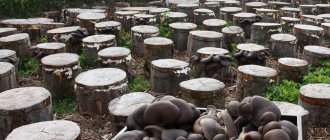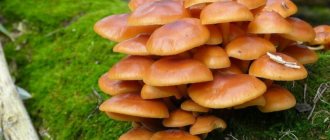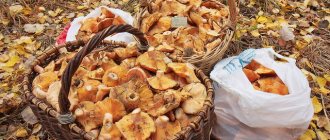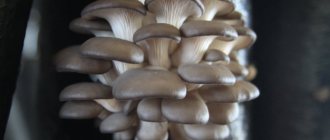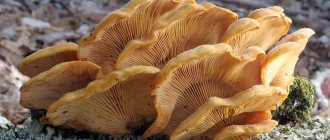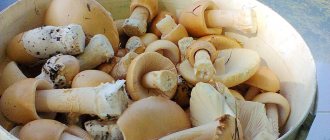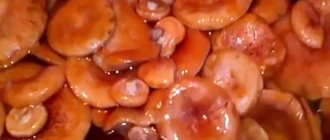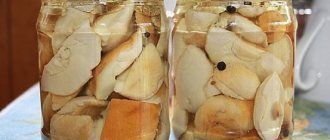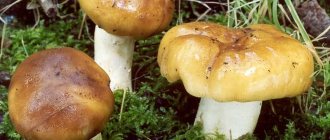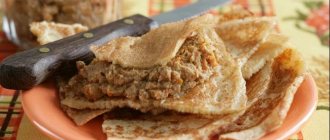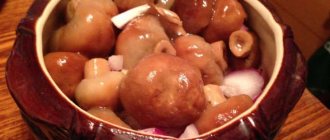- a Far Eastern variety of mushrooms of the oyster mushroom genus, the oyster mushroom family. A tasty and quite popular mushroom among mushroom pickers in Primorye and the Amur region. It grows from early May to October. In the wild it is found on dead trees or fallen trees of the Far Eastern elm - elm, for which it received its name. Quite productive. Depending on the presence of rain, it can form 5-7 layers per season. In China, it is successfully cultivated on birch, poplar and aspen wood. A good edible mushroom. Used fresh, dried and pickled.
Lemon oyster mushroom (ilmak)
What does the ilmak mushroom look like?
Translated from Latin, the name of the mushroom sounds like Pleurotus golden. People call oyster mushroom lemon, yellow, golden. However, more often the mushroom is called ilmovik or ilmak. The name was not given by chance. Oyster mushrooms of this species usually grow on elm, a common tree in the Far East. Fruiting bodies populate the trunk or stump in groups of up to 30 pieces. The family has no pattern of arrangement. Ilmacs simply parasitize the tree in compact clumps. Mushrooms are rarely found alone.
Yellow oyster mushroom grows in groups of about 30 mushrooms
If you compare the photos and descriptions of ilmak mushrooms, you can get a little confused. Most often you can see beautiful yellow caps in the image, but in reality they are almost white. There is nothing unusual here. It’s just that young ilmak trees are more often seen in the photos. The surface of their caps is truly lemon-yellow. The shape is flat. A small depression forms in the middle. As the oyster mushroom matures, the yellowness gradually disappears. The mushroom cap becomes white.
In nature, ilmak trees grow large in size. The diameter of the cap reaches from 5 to 30 cm. The spore-bearing layer consists of white plates. Sometimes they take on a pinkish tint. The plates are smooth, compacted among themselves, and smoothly pass from the cap to the stem. Mushroom pickers love ilmak for its fleshy pulp. The younger the oyster mushroom, the juicier and softer it is. The pulp is rougher in the area where the mushroom cap meets the stem. Experienced mushroom pickers recognize the type of oyster mushroom by its floury aroma
The leg of the ilmak is cream-colored. In large fruiting bodies, it can reach a length of 8 cm and a width of 3 cm. In the family, oyster mushrooms can be found with a long, elongated stalk or completely without it. This structure is due to the adaptation of ilmak trees to environmental conditions.
Description
Oyster mushroom (Pleurotus Pulmonarius) belongs to the Oyster mushroom family, genus Oysteraceae. This mushroom also has other names, such as:
- Spring oyster mushroom;
- Beech oyster mushroom;
- Oyster mushroom is whitish;
- Pleurotus whitish.
The mushroom is considered edible and healthy.
hat
The cap is of medium size, its diameter ranges from 4 to 8 cm, but sometimes representatives of this species are found with a cap up to 16 cm. The color of the skin of the cap is grayish-white or cream, sometimes light brown, darker at the place where the stem is attached. As it grows, the shade changes to yellowish. The edges of the cap are thin and curved upward, shaped more like an ear or a fan.
Hymenophore
The plates of the hymenophore are relatively sparse, dense, and descend along the stalk, have a white tint, and with age begin to turn yellow or become cream-colored. Sometimes this color is also found in young individuals.
Pulp
The flesh of the mushroom is dense, white-gray and has a pleasant smell and taste. The pulp on the stem is tough; in adult mushrooms it is tougher than in young ones.
Leg
The stem of the mushroom is short, cylindrical in shape without a cavity, mostly lateral, but can also be located in the center of the cap. The length reaches 4 cm, diameter - from 6 to 15 mm. The surface of the stalk is off-white in color, and its lower part is covered with hairs.
Where does the ilmak mushroom grow?
In the wild, ilmacs grow throughout the warm season, usually from May to September. Sometimes the harvest can be harvested even in early December. On the territory of Russia, massive growth of oyster mushrooms is observed in Primorye, as well as in the Southern Amur region. For mushrooms they go to the forests where cedar, elm and other broad-leaved trees grow. Clusters of yellow fruiting bodies are looked for on the trunks of weak or fallen trees and stumps.
Golden oyster mushroom can be found on stumps, growing and fallen tree trunks
Important! A feature of the species is good resistance to frost, which is rarely inherent in other mushrooms. With a strong drop in temperature, fruiting bodies slow down their growth and resume with the onset of warming.
In the video you can see how ilmak trees grow in Primorye:
Benefits, medicinal properties and possible harm
Even in ancient China, the mushroom was used as a means to strengthen the immune system; to enhance male potency and treat certain bacterial infections.
Currently, the bactericidal, immunostrengthening and antitumor properties of yellow oyster mushroom have been proven. Its fruiting bodies contain the substance lovastatin, which lowers blood sugar and cholesterol levels. Chemical compounds found in ilmak have a detrimental effect on viruses.
The most important thing at the moment is the possibility of obtaining antitumor drugs from ilmovik. A substance is secreted that inhibits the proliferation (growth) of malignant cells.
Oyster mushroom is a low-calorie mushroom that contains a sufficient amount of proteins and carbohydrates. Therefore, it is universal for any diet aimed at weight loss. Ilmovik has the ability to break down fats.
Possible harm when consuming mushrooms:
- heaviness in the stomach, flatulence and diarrhea due to overeating;
- difficulty digesting in children and the elderly;
- danger of poisoning from oyster mushrooms purchased from unscrupulous sellers.
But the real beneficial properties outweigh the likelihood of harmful ones. To avoid poisoning, buy mushrooms only from trusted sellers. If you collect it yourself, follow the storage conditions and collection rules.
Is it possible to eat yellow oyster mushrooms?
Ilmak is considered a completely edible mushroom. The pulp has excellent taste. Mushroom pickers value oyster mushrooms collected in the forest more than those grown on substrate. Wild fruiting bodies are more fragrant. The most popular recipe among mushroom pickers is ilmak with potatoes, where after picking mushrooms are fried with onions and then added to fried potatoes. Delicious oyster mushrooms, marinated, dried, salted.
Yellow oyster mushrooms look appetizing even growing on a tree
In adult mushrooms, the stem is often discarded. This is not due to her toxicity, but simply because she is rude. If the ilmak is very old, then remove part of the cap where it fuses with the stem.
Attention! Only those yellow oyster mushrooms that were collected near the highway or in contaminated areas are considered inedible.
In a slow cooker
Is it possible to cook chanterelles with potatoes in a slow cooker? Actually it is possible. But it is important to consider that the speed of cooking mushrooms and potatoes is very different. You will either burn the chanterelles (more than you need) or you will end up with raw potatoes. Of course, if you are an experienced cook, you will succeed, but we would not advise taking risks.
In general, repeat our basic recipe, only instead of 2 frying pans, use a multicooker bowl. First, you deal with frying the mushrooms, trying to undercook them a little, and then you start using the potatoes. If you adapt, everything will definitely work out!
How to cook ilmaki mushrooms
There are many recipes for cooking oyster mushrooms. The most popular are fried mushrooms alone and with potatoes, marinated, salted, stewed. It turns out delicious soup with ilmak, sauce, pizza or pie, where the fruiting bodies are used for filling.
It is advisable to boil wild mushrooms for about 10-15 minutes before cooking.
Before preparing the dish, the mushrooms need to be prepared. The procedure begins with cleaning. There is no need to remove the skin or spore-bearing layer from ilmacs. Simply use a brush and knife to clean off the dirt, cut off the damaged areas and the lower part of the leg. The fruiting bodies are washed and placed in a container with salted water so that they do not turn black. They are inspected again before cooking. If dark spots appear, they are cut off with a knife blade.
Chanterelles in tomato with potatoes
Quite an unusual way of preparing chanterelles. It is believed that these mushrooms are combined only with butter and white sauces. But recipes from the Internet prove otherwise. People try to cook chanterelles with tomatoes, and they do it very well! Let's take a closer look at how to cook this deliciously.
In any case, the cooking recipe is based on the classics that we described earlier. But this time after frying the mushrooms, you should add tomatoes to them. What options are there:
- Fresh tomatoes. Probably the best option for chanterelles. The tomatoes themselves are very tasty, but their aroma is weak enough to overpower the smell of chanterelles. The tomatoes should simply be cut into cubes, it is better to use a vegetable cutter for this, and added to the mushrooms 2-3 minutes before the end of frying. Immediately after this, they should be crushed with a spoon, being careful not to break the structure of the chanterelles. The vegetables will release their juice, and the pulp will create the necessary thick consistency.
- Tomato paste. Less preferred, but still a good option. Especially in winter, when there are no good tomatoes or they are unreasonably expensive. Choose pasta without unnecessary additives. We remember how quickly a dish can be ruined if you add anything with a strong aroma.
Do not add ready-made store-bought sauces: Krasnodar, various ketchups, fruit and vegetable sauces. Flavoring additives and cooking technologies transform sauces into a riot of flavors and colors. They will take over all the aromatics, and all that remains of the mushrooms will be the name.
Recipes for cooking ilmakov mushrooms
Every housewife has her own favorite recipe for making ilmaks. Moreover, mushrooms are not only eaten for pleasure, but also used for medicinal purposes.
Shredded ilmaki are an excellent ingredient for salad
One such example is a popular recipe for a tincture that helps strengthen the immune system and prevent the formation of tumors. To prepare, you need to pour 50 g of crushed ilmaks into 0.5 liters of wine. The finished tincture is taken for cardiovascular diseases three times a day, 1 tbsp. l. To fight tumors and mastopathy, 300 g of crushed ilmaks are infused with 500 g of vodka. If you need a tincture simply to strengthen the immune system, infuse 100 g of oyster mushrooms in the same amount of vodka.
In almost all recipes you need to cook ilmaki in a large amount of water. This is due to the fact that the mushroom releases a lot of juice during heat treatment. To cook oyster mushrooms, they are first filled with cold water. Add salt and spices according to your taste. Cooking time after boiling water is 20-30 minutes. The larger and older the mushrooms, the longer they need to be boiled. Place the finished oyster mushrooms in a colander and allow time to drain. Boiled mushrooms can be eaten immediately or used to prepare other dishes.
To fry ilmaki mushrooms, they do not need to be pre-cooked. The mushrooms will be tasty, aromatic and not watery. However, fruiting bodies are prepared without boiling if you are confident in their environmental purity. For example, oyster mushrooms are grown independently on a substrate or collected in the forest far from roads and industrial enterprises. To fry, ilmaki with onion rings are placed in a heated frying pan with vegetable oil. To prevent all the juice from evaporating, cover with a lid. Fry for about 20 minutes until golden brown. You can add vegetables or fried potatoes if you wish.
Casserole with potatoes and mushrooms with cheese crust
Ingredients
- 2 tablespoons flour;
- 600 ml milk;
- salt - to taste;
- ground black pepper - to taste;
- 1 teaspoon dried thyme;
- 3 cloves of garlic;
- 1 onion;
- 1 kg of potatoes;
- 500 g mushrooms;
- 1 tablespoon butter;
- 200 g hard cheese.
Preparation
In a frying pan, stirring lightly, lightly fry the flour until golden brown. Pour in the milk little by little, whisking constantly to avoid lumps. Season the sauce with salt, pepper and thyme.
Finely chop the onion and garlic. Add the vegetables to the sauce, stir and cook for another 5 minutes over low heat.
Cut the potatoes into thin slices, and the mushrooms into slices or small pieces. Grease a baking dish with butter. Place half the potatoes there, spread the mushrooms on top and brush them with half the sauce.
Add the remaining potatoes and spread the other half of the sauce over them. Bake at 190°C for approximately 45 minutes. Then sprinkle the dish with grated cheese and cook for another 10 minutes.
How to cook ilmaki for the winter
To enjoy mushrooms in winter, housewives salt, pickle, and freeze them. You can dry ilmaki, but this storage method is not very popular. Drying is often attacked by insects; if stored improperly, it disappears and loses its taste.
How to salt ilmaki
Salted ilmaki compete well with pickled mushrooms and are considered the best appetizer. A simple pickling recipe is designed for 0.5 kg of mushrooms. Pour 2 liters of water into a stainless steel or enamel pan, add 50 g of salt, add mushrooms and cook for up to 7 minutes. The finished ilmaki are discarded in a colander.
Pickling is one of the best ways to prepare food in winter.
For pickling, prepare a brine from 300 ml of water and 1 tbsp. l. salt. From the spices add 4 leaves of laurel and black currant, 4 black peppercorns. Bring the brine to a boil, cook for 5 minutes, let cool. The liquid is filtered through cheesecloth, boiled again without spices and allowed to cool. The mushrooms that have drained in a colander are placed in a sterilized jar. Ilmaki are filled with brine, covered with a lid, and sent to the refrigerator. After a week you can taste it.
How to marinate ilmaki
Marinated mushrooms are considered the #1 appetizer. Ilmaki is delicious in its pure form and as a salad ingredient. To marinate the harvested crop, you need to prepare a marinade. Add 1 tsp to 1 liter of water. sugar, 0.5 tbsp. l. salt and 1 tbsp. l. vinegar. Spices include bay leaf and black peppercorns. After the water boils, add all the ingredients along with the mushrooms and simmer for about 30 minutes. Ilmaks in the marinade are given a little time to cool, put into jars, and covered with lids. When the mushrooms have cooled completely, they are sent to the refrigerator.
For pickling, it is optimal to use 0.5 liter jars
How to freeze ilmaki
It is best to freeze oyster mushrooms that are pre-cooked. Once defrosted, they will be immediately ready to eat. The boiled fruiting bodies are allowed to drain in a colander. Each mushroom is individually laid out on a tray and placed in the freezer for 4 hours. When the oyster mushrooms become “glassy,” they are packaged in bags or plastic boxes and sent back to the freezer for long-term storage.
It is better to store frozen food in plastic boxes.
Advice! Mushrooms must be defrosted first in the refrigerator and then at room temperature so that the flesh is soft.
Ilmoviki can be frozen fresh, without boiling. The fruiting bodies need to be cleaned, rinsed quickly under water so that they do not become saturated with moisture and dried. Further steps are the same as with boiled oyster mushrooms.
Chanterelles in sour cream with fried potatoes
Many people love mushrooms with sour cream. The fact is that mushrooms, for all their positive taste, have practically no fat content. Sour cream compensates for this and gives the mushrooms a richness of taste. Chanterelles are no exception in this regard; they go well with good fat sour cream.
In order to get a tasty dish with the addition of sour cream, you should repeat the original recipe up to the 5th point. Just at the end of frying the mushrooms you should add 2-3 tablespoons of delicious fatty sour cream, at least 20%. If you choose a less fatty one, it will simply spread over the pan and will not give an emulsifying effect.
It is also important to add that with this method of preparation, the serving should be separate. If you mix mushrooms in sour cream with potatoes, you will end up with something strange and not very pleasant to look at. And as we said earlier, the appearance of a dish and its presentation affect the perception of taste.
And one last note: do not add butter to the potatoes after cooking if you plan to eat them with mushrooms in sour cream. The fact is that the combination of sour cream and butter will give the dish excess fat content, but may have a bad effect on the taste.
That seems to be all, but the recipe is actually very cool!
Collection rules
Mushroom picking should not be carried out near roads, landfills, or industrial enterprises. The fruiting bodies are twisted while holding the cap. If the family is large, it is better to cut the sprout with a sharp knife so as not to damage the mycelium. It is not advisable to take very old mushrooms. They can be wormy. In addition, the pulp of such fruiting bodies is coarse and difficult to process.
It is better to put the harvested crop in a container or basket.
Growing lemon oyster mushroom
In the photo, lemon oyster mushroom is growing in a bed loaded with substrate. However, the most common practice is to grow mushrooms in bags. The substrate is prepared from straw, hay, seed husks, and sawdust. The organic matter is poured with water, boiled for 2 hours, left to drain and cool. A substrate is considered good if it releases a few drops of water when squeezed with a fist.
At home, yellow oyster mushroom is grown on a substrate
Buy mycelium for planting. Store it temporarily in the refrigerator, but do not freeze it. When the substrate is ready, it is laid out in plastic bags. The mycelium is spread in layers. You need to wear gloves to avoid infection. Bags seeded with substrate are placed in a dark, cool room. After about 18-20 days, the mycelium will grow. Using a knife, cut slits into the bags through which the fruiting bodies will appear. The mushrooms are provided with a humidity of about 80%, an air temperature of up to + 25 ° C, and good ventilation. Hats are sprayed with water at room temperature 1-2 times a day.
When properly grown, a mushroom picker collects mushrooms for 6 months. The first two waves of the harvest are considered the most productive. The result is considered successful if 3 kg of oyster mushrooms are collected from 1 kg of mycelium.
